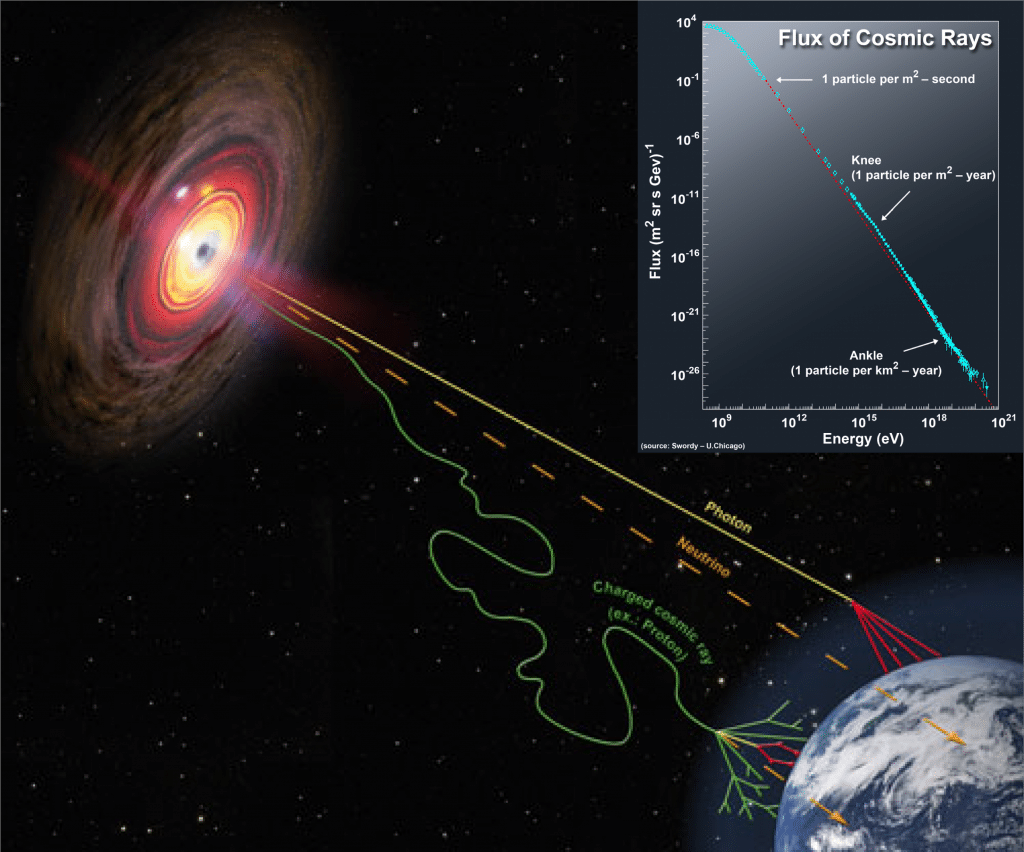Lee este artículo en español en nuestra CTA Newsletter.
Originally published in the March 2020 issue of the CTA Newsletter.
Written by: Heide Costantini and Ekrem Oğuzhan Angüner
Cosmic rays are charged particles, mainly protons and helium nuclei, that arrive isotropically (i.e. exhibiting the same behaviour in all directions) from space and continuously bombard Earth’s atmosphere. They were discovered by Victor Hess in 1912, when he measured an increasing radiation level in the atmosphere with altitude, using his balloon to reach a height of 5.3 km. He rightly postulated the extraterrestrial origin of cosmic rays and was awarded the Nobel Prize in Physics in 1936 for his discovery.
Decades of measurements helped to construct the energy spectrum of cosmic rays observed from Earth. It is one of the most famous plots of modern physics, exhibiting a remarkable power law in energy over several orders of magnitude (see inset in Figure 1). This power law has a break in energy at a few Peta-electronvolts (PeV,
1015 eV), which is referred to as the knee. Below the knee, cosmic rays are believed to be of Galactic origin, but the sources where they are produced are still unknown. Sources capable of accelerating particles up to at least PeV energies are called PeVatrons, and astronomers are actively on the hunt for these extreme accelerators within our Galaxy.
Several strong arguments suggest that the fast shock wave in the remnants of exploding stars (Supernova Remnants; SNRs), could be the acceleration site of cosmic rays and thus, the PeVatrons, too. Thus far, an emission detected by HAWC associated to SNR G106.3+2.7 suggests cosmic-ray proton acceleration up to PeV, but other scenarios related to electron acceleration cannot be ruled out [1]. Therefore, SNRs have not been established as a Galactic PeVatron yet, leaving this hypothesis still open.

Figure 1: The origin of cosmic rays is explored with neutral messengers, such as gamma rays. The inset shows the cosmic-ray energy spectrum observed from Earth with the main spectral features. Credit: HAP/A. Chantelauze
Understanding the origin of cosmic rays using direct measurements is an impossible task due to the presence of interstellar magnetic fields that deviate the path of these charged particles before they reach Earth. Neutral messengers generated by cosmic-ray interactions, such as gamma rays and neutrinos, are used to determine the origin of cosmic rays (Figure 1).
The gamma-ray energy is approximately a factor 10 lower than the parent cosmic-ray energy [2]. Thus, we can probe PeVatrons by searching for gamma-ray emission at energies up to 100 TeV and above. Current Imaging Atmospheric Cherenkov Telescopes (IACTs) have limited sensitivity above a few tens of TeV, which hampers measurements of the most interesting energy range for PeVatron investigation. Besides the putative SNR G106.3+2.7, so far, the discovery of only one PeVatron in our Galaxy has been reported by the H.E.S.S. Collaboration, located within the Galactic Center region, possibly connected to past active phases of the supermassive black hole Sgr A* [3]. This source is not powerful enough to explain the total amount of cosmic rays arriving on Earth; however, its detection has opened up new possibilities for the acceleration of PeV cosmic rays in our Galaxy, indicating that other types of astrophysical sources besides SNRs can be Galactic PeVatrons.
CTA, the next generation ground-based gamma-ray observatory, will include up to 70 Small-Sized Telescopes (SST) in its southern array (CTA-South), located in the Atacama Desert in Chile. The SSTs will be responsible for the high end of the observatory’s sensitivity between ~5 and 300 TeV. The large detection area of the SSTs improves by several orders of magnitude the gamma-ray sensitivity at TeV energies with respect to current IACTs and opens a new window to the unexplored Universe up to 300 TeV, boosting the probability of detecting PeVatrons.

Figure 2: Simulated images of the bright SNR RX J1713.7-3946, one of the main targets of CTA to study cosmic-ray acceleration, which illustrate different gamma-ray emission scenarios [6]. Credit: CTA Consortium
As part of its core scientific objectives, CTA will perform PeVatron searches using two strategies. The first is to observe known potential PeVatron candidates, provided by current IACTs and water Cherenkov detectors like HAWC [4,5], showing emission above a few tens of TeV together with no significant suppression in their gamma-ray spectrum. An ideal target is the SNR RX J1713.7-3946, due to its high brightness and many existing multiwavelength studies, whose CTA simulated emission under different theoretical scenarios is shown in Figure 2. The second strategy is to perform deep follow-up observations of new PeVatron candidates discovered during CTA’s Galactic Plane survey, which will provide an unprecedented dataset of new sources owing to the improved CTA sensitivity and angular resolution.
CTA will therefore be a unique instrument for PeVatron hunting, capable of detecting with unprecedented sensitivity and accuracy TeV gamma rays produced by PeV cosmic rays, which will significantly increase our chance to solve an almost 110-year-old mystery: Where do Galactic cosmic rays originate?
References:
[1] Albert, A. et al. (HAWC Collaboration) ApJL 896, L29 (2020)
[2] Kelner, S. R., Aharonian, F. A., Bugayov, V. V., 2006, Phys. Rev. D, 74, 034018 (2006)
[3] Abramowski et al. (H.E.S.S. collaboration), Nature 531, 476-479 (2016)
[4] Abdalla, H. et al. (H.E.S.S. collaboration), A&A 612, A1 (2018)
[5] Abeysekara, A. U. et al. (HAWC Collaboration), Phys. Rev. Lett. 124, 021102 (2020)
[6] Acero, F. et al. (The CTA Consortium), ApJ 840, 2, 74 (2017)